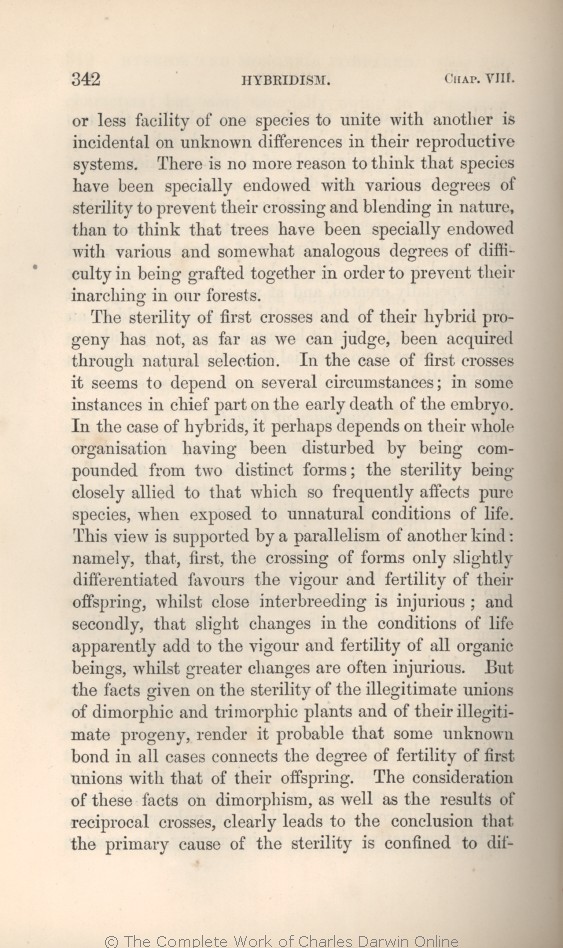The sterility of first crosses
and of their hybrid progeny has not, as far as we can judge, been acquired through natural selection. | and of their hybrid progeny has not, as far as we can judge, been acquired through natural selection. 1869 |
| between pure species, which have their reproductive systems perfect, seems to depend on several circumstances; in some cases largely on the early death of the embryo. 1859 1860 1861 |
| and of their hybrid progeny has not, as far as we can judge, been increased through natural selection so as to attain that high degree which is universal with species when rendered widely distinct. 1866 |
| and of their hybrid progeny has not been acquired through natural selection. In the case of first crosses it seems to depend on several circumstances; in some instances in chief part on the early death of the embryo. 1872 |
| In the case of 1869 |
| With 1866 |
| it 1869 |
| between pure species, in which the reproductive system is in a perfect condition, the sterility 1866 |
| instances in chief part 1869 |
| cases largely 1866 |
| ..... 1869 | | apparently 1866 |
| ..... 1869 | | imperfection 1866 |
| ..... 1869 | | impregnation. 1866 |
| 2 blocks not present in 1859 1860 1861 1866 1869; present in 1872 | | In the case of hybrids, it apparently depends on their whole organisation having been disturbed by being compounded from two distinct forms; the sterility being closely allied to that which so frequently affects pure species, when exposed to new and unnatural conditions of life.
He who will explain these latter cases will be able to explain the sterility of hybrids.
|
| In the case of hybrids, it perhaps depends on their 1869 |
| The sterility of hybrids, which have their reproductive systems imperfect, and which have had this system and their 1859 1860 1861 |
| With hybrids, in which the reproductive system is in an imperfect condition, and in which this system as well as the 1866 |
| having been disturbed 1869 |
| disturbed 1859 1860 1861 |
| has been disturbed 1866 |
| from 1866 1869 | | of 1859 1860 1861 |
| forms; the sterility being 1869 |
| species, seems 1859 1860 1861 |
| forms, the sterility apparently is 1866 |
| ..... 1866 1869 | | sterility 1859 1860 1861 |
| exposed to 1866 1869 | | their 1859 1860 1861 |
| unnatural 1866 1869 | | natural 1859 1860 1861 |
| life. 1866 1869 | | life 1859 1860 1861 |
| ..... 1866 1869 | | have 1859 1860 1861 |
| ..... 1866 1869 | | been 1859 1860 1861 |
| ..... 1866 1869 | | disturbed. 1859 1860 1861 |
| supported 1859 1860 1861 1866 1869 | | strongly supported 1872 |
| kind: 1866 1869 1872 | | kind;— 1859 1860 | | kind:— 1861 |
| that, 1869 1872 | | that 1859 1860 1861 1866 |
| first, the crossing of forms only slightly differentiated favours 1869 |
| the crossing of forms only slightly different is favourable to 1859 1860 1861 |
| the crossing of forms only slightly differentiated favours 1866 |
| firstly, slight changes in the conditions of life add to 1872 |
| their offspring, whilst close interbreeding is injurious; and secondly, that slight changes in the 1869 |
| their offspring; and that slight changes in the 1859 1860 1861 1866 |
| all organic beings; and secondly, that the crossing of forms, which have been exposed to slightly different 1872 |
| apparently add to the 1866 1869 |
| are apparently favourable to the 1859 1860 1861 |
| or which have varied, favours the size, 1872 |
| vigour 1859 1860 1861 1866 1869 | | vigour, 1872 |
| all organic beings, whilst greater changes are often injurious. 1869 |
| all organic beings. 1859 1860 1861 1866 |
| their offspring. 1872 |
| But the 1866 1869 | | The 1872 |
| render 1866 1869 | | perhaps render 1872 |
| ..... 1869 1872 | | there is 1866 |
| in all cases connects 1869 1872 |
| connecting in all cases 1866 |
| clearly leads to the conclusion that 1869 1872 |
| drive us to conclude that in all cases 1866 |
| the sterility is confined to dif- ferences in the sexual elements. 1869 |
| sterility, both in the parents and in the offspring, is confined to differences in their reproductive systems. 1866 |
| the sterility of crossed species is confined to differences in their sexual elements. 1872 |
|









